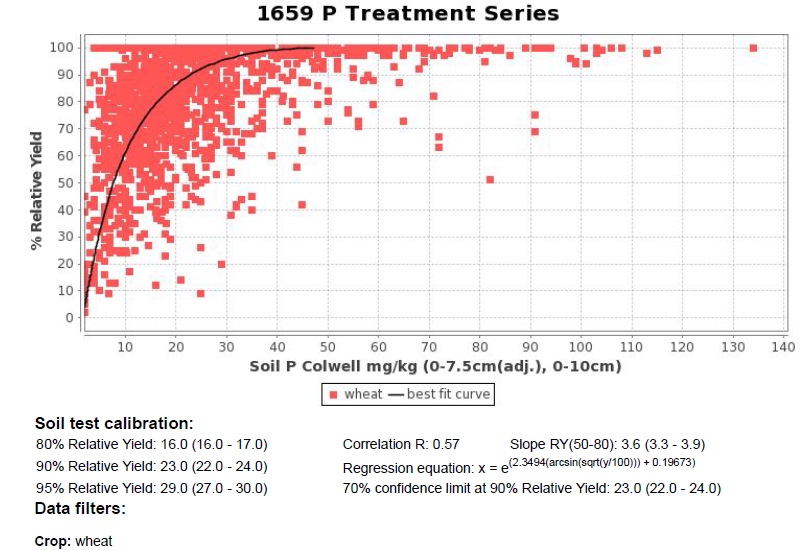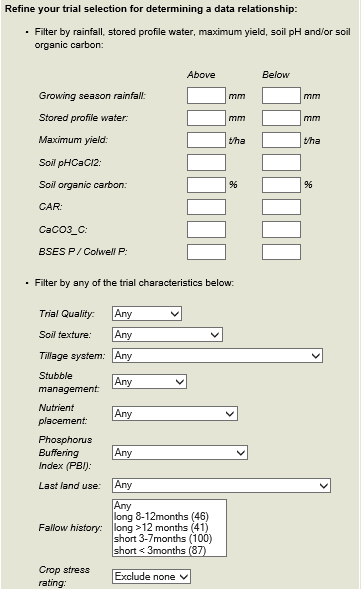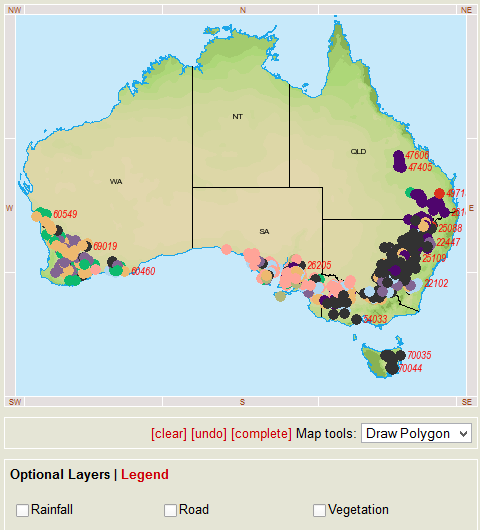BFDC Interrogator
Author: Kaara Klepper, Department of Agriculture, Fisheries and Forestry, Queensland, Chris Dowling, Back Paddock Company P/L | Date: 05 Mar 2014
A new tool for exploring soil test critical levels and crop responsiveness in broadacre crops
GRDC codes: DAQ00183, DAN00166
Authors
Kaara Klepper, DAFF Qld
Chris Dowling, Back Paddock Company
Take home message
Have you ever wondered about the origins of soil test critical levels for N, P, K and S for broadacre crops and wanted to explore or validate critical ranges for your soil types, locality and circumstances? This is now possible by way of a web-tool developed with GRDC funding called the Better Fertiliser Decision for Cropping in Australia (BFDC) Interrogator. The database underlying the BFDC Interrogator contains the results of more than 5000 soil test calibration experiments conducted in Australia since the 1950s. Fertiliser decisions made by grain growers and their advisers should all start with, and rely on, objective knowledge of the fertility status of paddocks. The BDFC Interrogator provides information about soil test critical levels for the four nutrients that frequently account for 20-30% of variable crop production costs - N, P, K and S.BFDC interrogator training is now online at www.bfdc.com.au.
Attendance at the workshop sessions will let you explore the response database, provide participants with the information to help gain unlimited access to BFDC Interrogator and involve discussion about concepts of crop nutrition and crop nutrition research.
GRDC continue to invest in BFDC, including an online data entry tool, inclusion of long term trials and N, P, K and S research trials to fill gaps in knowledge
Background
The Making Better Fertiliser Decisions for Cropping Systems in Australia project (BFDC) aims to provide the fertiliser industry, agency staff and agribusiness advisors and farmers with knowledge and resources to improve nutrient recommendations for optimising crop production. The BFDC database is a national database of historical fertiliser response data for the main grain crops grown in Australia. BFDC is recognised by the Fertiliser Industry Federation of Australia as the best available data for supporting the decision tools that fertiliser industry members use as the basis for interpretation of soil tests and formulating recommendations.Fertiliser decisions made by grain growers and their advisers should all start with, and rely on, objective knowledge of the fertility status of paddocks. These decisions need to account for the nutrient requirements of plants for growth, nutrient availability in soils, and nutrient losses that can occur during crop growth (e.g. de-nitrification or erosion).
Making better decisions about soil nutrient management and crop nutrition starts with gaining an understanding of how soil fertility fits into the whole crop production process. The BDFC Interrogator provides information about soil test critical levels for the four nutrients that frequently account for 20-30% of variable crop production costs - N, P, K and S.
For an overview of the development, processes, research findings and relevance of the BFDC see the following paper
Speirs S, Reuter DJ, Peverill KI, Brennan RF (2013) Making Better Fertiliser Decisions for Cropping Systems in Australia: an Overview http://dx.doi.org/10.1071/CP13034
BFDC Interrogator
Soil test-crop response (N, P, K and S fertiliser) trials have been undertaken by many different organisations in Australia since the late 1950's. As new soil tests were developed, soil test criteria (defining soil test values at near optimum or maximum yield for a specific crop) were developed for interpreting the nutrient status of cropping soils for growers.Trial results have been recorded in scientific publications, project reports, extension publications (e.g. regional trial report books) or field and office archives. Commonly, experimental designs varied from trial to trial and hence different amounts of data were collected and reported.
All of the relevant soil test-crop response data that could be obtained for each trial have been entered into the BFDC database. Up to 50 % of the trials conducted during the period were unable to be used in the database as a result of poor design (e.g. nutrient rate not sufficient to define Ymax) or a lack of data essential for interpretation (e.g. records of associated soil test and depth). Interestingly the database is dominated (60%) by responses of wheat to N and P, highlighting limited data are available for current cropping systems and varieties. The value of the dataset and lessons learnt from it is explored in the following paper
Conyers MK, Bell MJ, Wilhelm NS, Bell R, Norton RM, Walker C (2013) Making Better Fertiliser Decisions for Cropping Systems in Australia (BFDC): Knowledge gaps and lessons learnt http://dx.doi.org/10.1071/CP13068
A web application namely, BFDC interrogator provides access to the BFDC database, allowing registered users to query the data held in the BFDC database so that soil test-crop response relationships and critical soil test values based on specified criteria (e.g. a cropping region or soil type) can be derived for different crops.
A soil test-crop response calibration for a specific crop type (e.g. wheat) is the relationship between the measured yield increase to an applied nutrient at a range of experimental sites and the soil test value for each trial site.
Researchers have commonly used the percent relative yield (% RY) (either as grain yield or crop biomass yield at flowering or crop maturity) as the estimate of yield responsiveness, largely because this estimate partially circumvents variations in yield responses to applied nutrient between sites and to variations in seasonal conditions that could affect grain yield and/or yield responsiveness to an applied nutrient.
The BFDC Interrogator generates critical soil test values for N, P, K and S. The figure below shows all soil test – crop response records for Colwell P and wheat.
Figure 1. Output from a BFDC Interrogator query for P (Colwell) calibration in wheat, including all records in the BFDC database
Long description:
80% Relative Yield: 16.0 (16.0 - 17.0)
90% Relative Yield: 23.0 (22.0 - 24.0)
95% Relative Yield: 29.0 (27.0 - 30.0)
Correlation R: 0.57
Slope RY (50 - 80): 3.6 (3.3 - 3.9)
Regression equation: x = e(2.3494(arcsin(sqrt(y/100))) + 0.19673
70% confidence limit at 90% Relative Yield: 23.0 (22.0 - 24.0)
The critical soil test level (and the variance, called the critical range) is defined at near maximum relative yield. The BFDC Interrogator determines the critical soil test criterion at 80, 90 and 95% RY.
These associated trial data collected has been recorded against the response and can be partitioned to better define the critical soil test level according to factors such as
- Geographic location
- Soil types or soil texture classes.
- Crop descriptors (e.g. crop type).
- Environmental characteristics (e.g. growing season rainfall).
Soil test – crop response
There have been a number of scientific publications (Crop & Pasture Science Special Issue, Volume 64) derived from the trial data contained within the BFDC dataset. These papers explore soil test – crop response relationships and critical soil test values for N, P K and S around selected parameters including location, crop type and rainfall.
Nitrogen
Bell MJ, Strong W, Elliott D, Walker C (2013b) Soil nitrogen—crop response calibration relationships and criteria for winter cereal crops grown in Australia. Crop & Pasture Science 64, 442–460.
Phosphorus
Bell MJ, Moody PW, Anderson GC, Strong W (2013a) Soil phosphorus—crop response calibration relationships and criteria for oilseeds, grain legumes and summer cereal crops grown in Australia. http://dx.doi.org/10.1071/CP12428Bell R, Reuter DJ, Scott BJ, Sparrow L, Strong W, the late Chen W (2013) Soil phosphorus—crop response calibration relationships and criteria for winter cereal crops grown in Australia. http://dx.doi.org/10.1071/CP13016
Moody PW, Speirs SD, Scott BJ, Mason SD (2013) Soil phosphorus tests I: What soil phosphorus pools and processes do they measure? Crop & Pasture Science 64, 461–468.
Speirs SD, Scott BJ, Moody PW, Mason SD (2013b) Soil phosphorus tests II: A comparison of soil test–crop response relationships for different soil tests and wheat. Crop & Pasture Science 64, 469–479.
Potassium
Brennan RF, Bell MJ (2013) Soil potassium—crop response calibration relationships and criteria for field crops grown in Australia. Crop & Pasture Science 64, 514–522.
Sulfur
Anderson GC, Peverill KI, Brennan RF (2013) Soil sulfur—crop response calibration relationships and criteria for field crops grown in Australia. Crop & Pasture Science 64, 523–530.
BFDC training
Significant work has been undertaken to roadtest the training. Validation of training methodologies and the course content can be viewed in the following paper.Dowling CW, Speirs SD (2013) An extension perspective—increasing the adoption of more reliable soil test interpretation. http://dx.doi.org/10.1071/CP13216
The face to face training has been taken to an online self paced interactive form. Gaining access to the BFDC Interrogator is possible by undertaking a half day face to face or self-paced online familiarisation course that ensures users are aware of the intended uses, limitations and statistical rules, and to ensure the outputs of an interrogation of the database is reliable and fit for purpose. Generally the face to face and online courses would take 4 – 6 hours to complete. By attending the BFDC Interrogator sessions to be held during the concurrent sessions at the GRDC Adviser Updates at Coonabarabran and Goondiwindi in 2014, you will have reduced the time to complete the training to as little as 1 - 1.5 hours.
Reference
Peverill K, Reuter D, Conyers M and Norton R 2013 Making Better Fertiliser Decisions for Cropping Systems in Australia Crop & Pasture Science Special Issue, Volume 64, Number 5, CSIRO PUBLISHING.
Contact details
Chris Dowling
Back Paddock Company
Mb: 0407 692 2510407 692 251
Ph: 07 0382 1354407 0382 13544
Email: cdowling@backpaddock.com.au
Was this page helpful?
YOUR FEEDBACK




